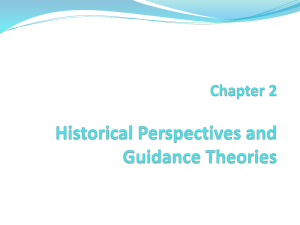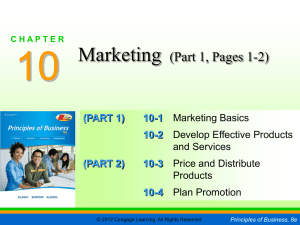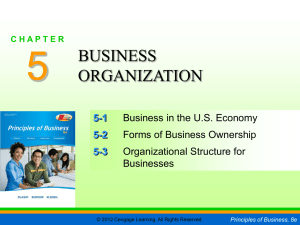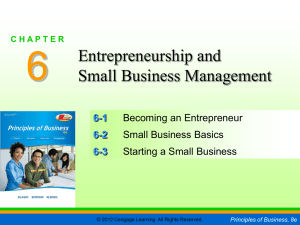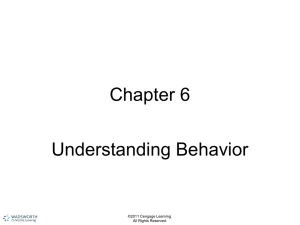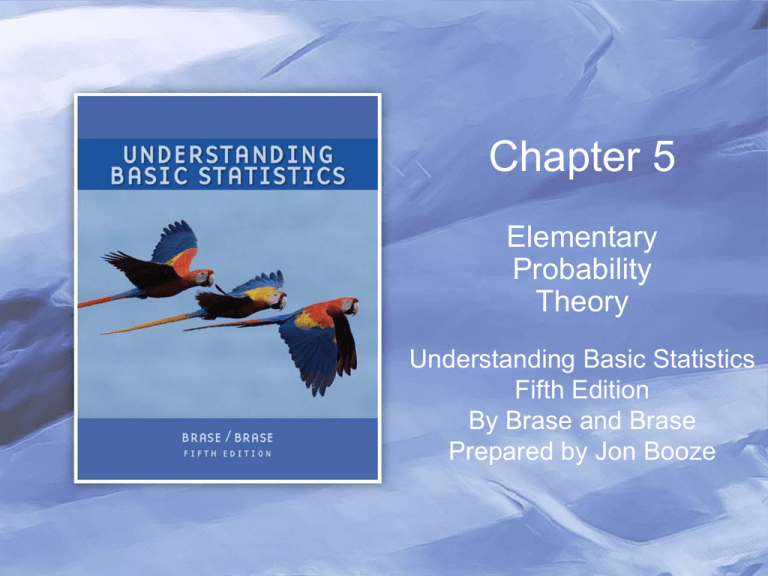
Chapter 5
Elementary
Probability
Theory
Understanding Basic Statistics
Fifth Edition
By Brase and Brase
Prepared by Jon Booze
Probability
• Probability is a numerical measure that
indicates the likelihood of an event.
• All probabilities are between 0 and 1, inclusive.
• A probability of 0 means the event is
impossible.
• A probability of 1 means the event is certain to
occur.
• Events with probabilities near 1 are likely to
occur.
Copyright © Cengage Learning. All rights reserved.
5|2
Probability
• Events can be named with capital letters:
A, B, C…
• P(A) means the probability of A occurring.
– P(A) is read “P of A”
– 0 ≤ P(A) ≤ 1
Copyright © Cengage Learning. All rights reserved.
5|3
Probability Assignment
• Assignment by intuition – based on intuition,
experience, or judgment.
• Assignment by relative frequency –
f
P(A) = Relative Frequency =
n
• Assignment for equally likely outcomes
Number of Outcomes Favorable to Event A
P( A)
Total Number of Outcomes
Copyright © Cengage Learning. All rights reserved.
5|4
Probability Assignment
Among a sample of 50 dog owners, 23 feed their
dogs Mighty Mutt dry dog food.
Calculate the relative frequency of Mighty Mutt
users.
a). 23/50
b). 27/50
Copyright © Cengage Learning. All rights reserved.
c). 1/23
d). 23/27
5|5
Probability Assignment
Among a sample of 50 dog owners, 23 feed their
dogs Mighty Mutt dry dog food.
Calculate the relative frequency of Mighty Mutt
users.
a). 23/50
b). 27/50
Copyright © Cengage Learning. All rights reserved.
c). 1/23
d). 23/27
5|6
Law of Large Numbers
• In the long run, as the sample size increases,
the relative frequency will get closer and closer
to the theoretical probability.
Example: Toss a coin repeatedly. The relative
frequency gets closer and closer to P(tails) =
0.50
Relative
Frequency
f = number of
tails
n = number of
flips
0.52
0.518
0.495
104
259
495
1006
2498
200
500
1000
2000
5000
Copyright © Cengage Learning. All rights reserved.
0.503 0.4996
5|7
Probability Definitions
• Statistical Experiment: Any random activity that
results in a definite outcome.
• Event: A collection of one or more outcomes in
a statistical experiment.
• Simple Event: An event that consists of exactly
one outcome in a statistical experiment.
• Sample Space: The set of all simple events.
Copyright © Cengage Learning. All rights reserved.
5|8
The Sum Rule
• The sum of the probabilities of all the simple
events in the sample space must equal 1.
Copyright © Cengage Learning. All rights reserved.
5|9
The Complement Rule
• The complement of event A is the event that A
does not occur, denoted by Ac
• P(Ac) = 1 – P(A)
Copyright © Cengage Learning. All rights reserved.
5 | 10
The Complement Rule
The probability of randomly drawing an ace from a
standard deck of cards is 1/13.
What is the probability of not drawing an ace from
a standard deck?
a). 1/13
b). 12/13
c). 13/1
d). 4/13
Copyright © Cengage Learning. All rights reserved.
5 | 11
The Complement Rule
The probability of randomly drawing an ace from a
standard deck of cards is 1/13.
What is the probability of not drawing an ace from
a standard deck?
a). 1/13
b). 12/13
c). 13/1
d). 4/13
Copyright © Cengage Learning. All rights reserved.
5 | 12
Probability versus Statistics
• Probability is the field of study that makes
statements about what will occur when a
sample is drawn from a known population.
• Statistics is the field of study that describes how
samples are to be obtained and how inferences
are to be made about unknown populations.
Copyright © Cengage Learning. All rights reserved.
5 | 13
Independent Events
• Two events are independent if the occurrence
or nonoccurrence of one event does not change
the probability of the other event.
Copyright © Cengage Learning. All rights reserved.
5 | 14
Independent Events
Which of the following represent independent
events?
a). Two hearts are drawn from a standard deck of
cards.
b). Two dice are rolled resulting in a “2” and a “5”.
c). Both a and b.
d). Neither a nor b.
Copyright © Cengage Learning. All rights reserved.
5 | 15
Independent Events
Which of the following represent independent
events?
a). Two hearts are drawn from a standard deck of
cards.
b). Two dice are rolled resulting in a “2” and a “5”.
c). Both a and b.
d). Neither a nor b.
Copyright © Cengage Learning. All rights reserved.
5 | 16
• Multiplication Rule for Independent Events
P( A and B) P( A) P( B)
• General Multiplication Rule – For all events
(independent or not):
P( A and B) P( A) P( B | A)
P( A and B) P( B) P( A | B)
• Conditional Probability (when P( B) 0 ):
P ( A and B)
P( A | B)
P( B)
Copyright © Cengage Learning. All rights reserved.
5 | 17
Meaning of “A and B”
Copyright © Cengage Learning. All rights reserved.
5 | 18
Meaning of “A or B”
Copyright © Cengage Learning. All rights reserved.
5 | 19
Multiplication Rule
Two cards are selected at random from a standard
deck of cards.
Find the probability that both cards are clubs.
a). 1/17
b). 1/16
c). 1/12
d). 2/13
Copyright © Cengage Learning. All rights reserved.
5 | 20
Multiplication Rule
Two cards are selected at random from a standard
deck of cards.
Find the probability that both cards are clubs.
a). 1/17
b). 1/16
c). 1/12
d). 2/13
Copyright © Cengage Learning. All rights reserved.
5 | 21
Mutually Exclusive Events
• Two events are mutually exclusive if they
cannot occur at the same time.
• Mutually Exclusive = Disjoint
• If A and B are mutually exclusive, then
P(A and B) = 0
Copyright © Cengage Learning. All rights reserved.
5 | 22
Addition Rules
• If A and B are mutually exclusive, then
P(A or B) = P(A) + P(B).
• If A and B are not mutually exclusive, then
P(A or B) = P(A) + P(B) – P(A and B).
Copyright © Cengage Learning. All rights reserved.
5 | 23
Addition Rules
If a card is drawn at random from a standard deck
of cards, find the probability that the card is a
Jack or a spade.
a). 3/13
b). 7/26
c). 5/13
d). 4/13
Copyright © Cengage Learning. All rights reserved.
5 | 24
Addition Rules
If a card is drawn at random from a standard deck
of cards, find the probability that the card is a
Jack or a spade.
a). 3/13
b). 7/26
c). 5/13
d). 4/13
Copyright © Cengage Learning. All rights reserved.
5 | 25
Critical Thinking
• Pay attention to translating events described by
common English phrases into events described
using and, or, complement, or given.
• Rules and definitions of probabilities have
extensive applications in everyday lives.
Copyright © Cengage Learning. All rights reserved.
5 | 26
Multiplication Rule for Counting
This rule extends to outcomes involving three, four,
or more series of events.
Copyright © Cengage Learning. All rights reserved.
5 | 27
Multiplication Rule for Counting
A coin is tossed and a six-sided die is rolled. How
many outcomes are possible?
a). 8
b). 10
Copyright © Cengage Learning. All rights reserved.
c). 12
d). 18
5 | 28
Multiplication Rule for Counting
A coin is tossed and a six-sided die is rolled. How
many outcomes are possible?
a). 8
b). 10
Copyright © Cengage Learning. All rights reserved.
c). 12
d). 18
5 | 29
Tree Diagrams
• Displays the outcomes of an experiment
consisting of a sequence of activities.
– The total number of branches equals the
total number of outcomes.
– Each unique outcome is represented by
following a branch from start to finish.
Copyright © Cengage Learning. All rights reserved.
5 | 30
Tree Diagrams with Probability
• We can also label each branch of the tree with
its respective probability.
• To obtain the probability of the events, we can
multiply the probabilities as we work down a
particular branch.
Copyright © Cengage Learning. All rights reserved.
5 | 31
Urn Example
• Place five balls in an urn: three red and two
blue. Select a ball, note the color, and, without
replacing the first ball, select a second ball.
Four possible outcomes:
Red, Red
Red, Blue
Blue, Red
Blue, Blue
Probabilities are found by
using the multiplication rule
for dependent events.
Copyright © Cengage Learning. All rights reserved.
5 | 32
The Factorial
• n! = (n)(n – 1)(n – 2)…(2)(1), n a counting number
• By definition,
1! = 1
0! = 1
Example:
5! = 5·4·3·2·1 = 120
Copyright © Cengage Learning. All rights reserved.
5 | 33
Permutations
• Permutation: ordered grouping of objects.
• Example Permutation:
Seats 1 through 5 are occupied by Alice,
Bruce, Carol, Dean, and Estefan, respectively.
Copyright © Cengage Learning. All rights reserved.
5 | 34
Permutations
For a group of seven people, how many ways can
four of them be seated in four chairs?
a). 35
b). 3
Copyright © Cengage Learning. All rights reserved.
c). 28
d). 840
5 | 35
Permutations
For a group of seven people, how many ways can
four of them be seated in four chairs?
a). 35
b). 3
Copyright © Cengage Learning. All rights reserved.
c). 28
d). 840
5 | 36
Combinations
• A combination is a grouping that pays no
attention to order.
• Example Combination:
Out of a set of 20 people, Alice, Bruce, Carol,
Dean, and Estefan are chosen to be seated.
Copyright © Cengage Learning. All rights reserved.
5 | 37
Combinations
Among eleven people, how many ways can eight of
them be chosen to be seated?
a). 6,652,800
b). 165
c). 3
Copyright © Cengage Learning. All rights reserved.
d). 88
5 | 38
Combinations
Among eleven people, how many ways can eight of
them be chosen to be seated?
a). 6,652,800
b). 165
c). 3
Copyright © Cengage Learning. All rights reserved.
d). 88
5 | 39

